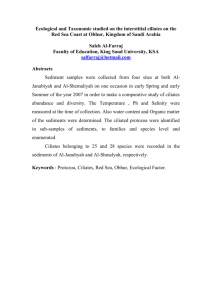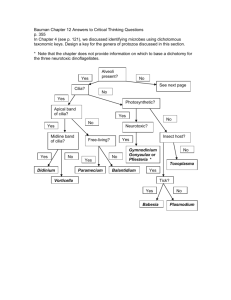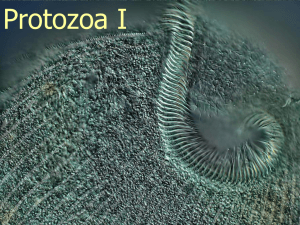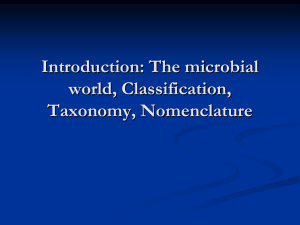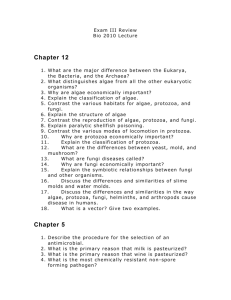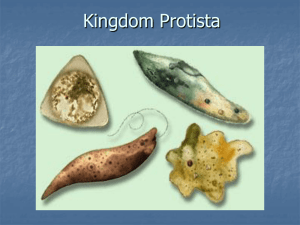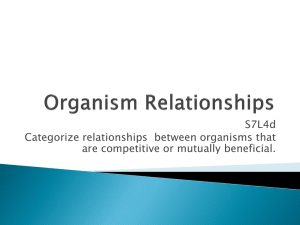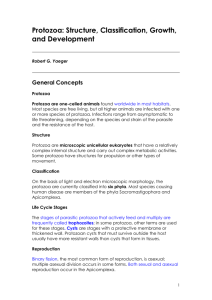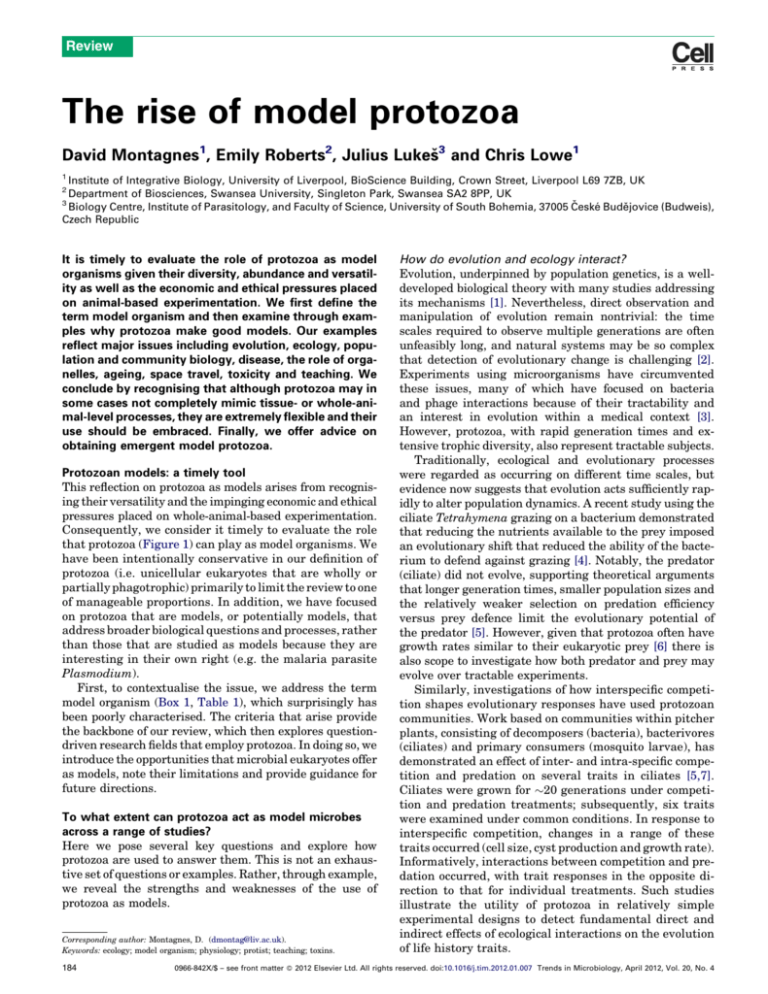
Review
The rise of model protozoa
David Montagnes1, Emily Roberts2, Julius Lukeš3 and Chris Lowe1
1
Institute of Integrative Biology, University of Liverpool, BioScience Building, Crown Street, Liverpool L69 7ZB, UK
Department of Biosciences, Swansea University, Singleton Park, Swansea SA2 8PP, UK
3
Biology Centre, Institute of Parasitology, and Faculty of Science, University of South Bohemia, 37005 České Budějovice (Budweis),
Czech Republic
2
It is timely to evaluate the role of protozoa as model
organisms given their diversity, abundance and versatility as well as the economic and ethical pressures placed
on animal-based experimentation. We first define the
term model organism and then examine through examples why protozoa make good models. Our examples
reflect major issues including evolution, ecology, population and community biology, disease, the role of organelles, ageing, space travel, toxicity and teaching. We
conclude by recognising that although protozoa may in
some cases not completely mimic tissue- or whole-animal-level processes, they are extremely flexible and their
use should be embraced. Finally, we offer advice on
obtaining emergent model protozoa.
Protozoan models: a timely tool
This reflection on protozoa as models arises from recognising their versatility and the impinging economic and ethical
pressures placed on whole-animal-based experimentation.
Consequently, we consider it timely to evaluate the role
that protozoa (Figure 1) can play as model organisms. We
have been intentionally conservative in our definition of
protozoa (i.e. unicellular eukaryotes that are wholly or
partially phagotrophic) primarily to limit the review to one
of manageable proportions. In addition, we have focused
on protozoa that are models, or potentially models, that
address broader biological questions and processes, rather
than those that are studied as models because they are
interesting in their own right (e.g. the malaria parasite
Plasmodium).
First, to contextualise the issue, we address the term
model organism (Box 1, Table 1), which surprisingly has
been poorly characterised. The criteria that arise provide
the backbone of our review, which then explores questiondriven research fields that employ protozoa. In doing so, we
introduce the opportunities that microbial eukaryotes offer
as models, note their limitations and provide guidance for
future directions.
To what extent can protozoa act as model microbes
across a range of studies?
Here we pose several key questions and explore how
protozoa are used to answer them. This is not an exhaustive set of questions or examples. Rather, through example,
we reveal the strengths and weaknesses of the use of
protozoa as models.
Corresponding author: Montagnes, D. (dmontag@liv.ac.uk).
Keywords: ecology; model organism; physiology; protist; teaching; toxins.
184
How do evolution and ecology interact?
Evolution, underpinned by population genetics, is a welldeveloped biological theory with many studies addressing
its mechanisms [1]. Nevertheless, direct observation and
manipulation of evolution remain nontrivial: the time
scales required to observe multiple generations are often
unfeasibly long, and natural systems may be so complex
that detection of evolutionary change is challenging [2].
Experiments using microorganisms have circumvented
these issues, many of which have focused on bacteria
and phage interactions because of their tractability and
an interest in evolution within a medical context [3].
However, protozoa, with rapid generation times and extensive trophic diversity, also represent tractable subjects.
Traditionally, ecological and evolutionary processes
were regarded as occurring on different time scales, but
evidence now suggests that evolution acts sufficiently rapidly to alter population dynamics. A recent study using the
ciliate Tetrahymena grazing on a bacterium demonstrated
that reducing the nutrients available to the prey imposed
an evolutionary shift that reduced the ability of the bacterium to defend against grazing [4]. Notably, the predator
(ciliate) did not evolve, supporting theoretical arguments
that longer generation times, smaller population sizes and
the relatively weaker selection on predation efficiency
versus prey defence limit the evolutionary potential of
the predator [5]. However, given that protozoa often have
growth rates similar to their eukaryotic prey [6] there is
also scope to investigate how both predator and prey may
evolve over tractable experiments.
Similarly, investigations of how interspecific competition shapes evolutionary responses have used protozoan
communities. Work based on communities within pitcher
plants, consisting of decomposers (bacteria), bacterivores
(ciliates) and primary consumers (mosquito larvae), has
demonstrated an effect of inter- and intra-specific competition and predation on several traits in ciliates [5,7].
Ciliates were grown for 20 generations under competition and predation treatments; subsequently, six traits
were examined under common conditions. In response to
interspecific competition, changes in a range of these
traits occurred (cell size, cyst production and growth rate).
Informatively, interactions between competition and predation occurred, with trait responses in the opposite direction to that for individual treatments. Such studies
illustrate the utility of protozoa in relatively simple
experimental designs to detect fundamental direct and
indirect effects of ecological interactions on the evolution
of life history traits.
0966-842X/$ – see front matter ß 2012 Elsevier Ltd. All rights reserved. doi:10.1016/j.tim.2012.01.007 Trends in Microbiology, April 2012, Vol. 20, No. 4
Review
Trends in Microbiology April 2012, Vol. 20, No. 4
(a)
(d)
(b)
(e)
(c)
(f)
TRENDS in Microbiology
Figure 1. Six examples of protozoa (phagotrophic eukaryotes) that act as models. (a) Tetrahymena, a ciliate that has a versatile model role (see the text); image from the
Open Access source [77]. (b) The ciliates Paramecium and Didinium are used to evaluate predator–prey dynamics among other roles; image kindly provided by K.
Hausmann. (c) Oxyrrhis is a marine flagellate that is emerging as model for a range of topics [61]; image by D. Patterson and provided courtesy of microscope.mbl.edu. (d)
Trypanosoma is a blood parasite that provides a source of mitochondria among other attributes; image rights obtained from Eye of Science. (e) Dictyostelium is a soil
amoeba that is possibly the most important medical-model protozoon; image kindly provided by R.L. Blanton. (f) Monosiga is a choanoflagellate that is emerging as a
model because of its phylogenetic affinity to metazoa [62]; image kindly provided by the King Laboratory, UC Berkeley.
How do populations and communities function?
For almost 100 years, numeric models have evaluated population and community dynamics and predicted events [8].
Most studies use either field data or a very limited number of
laboratory data (Figure 2). Microbial microcosms are now
also recognised as useful tools for exploring ecological issues
[9], and protozoan-based systems are being appreciated as
instructive in both theoretical and predictive terms [10].
Below, we provide two examples of protozoan-based ecological studies that examine model parameterisation.
Box 1. What is a model organism?
Nanny [64] referred to a select group of ciliates, such as Paramecium,
as ‘the chosen few’, because they have long acted as successful
experimental tools. This contention reflects Krogh’s principle that ‘for
such a large number of problems there will be some animal of choice,
or a few such animals, on which it can be most conveniently studied’
[65]. However, we must also reflect on the wise words of Box and
Draper [60]: ‘Remember that all models are wrong; the practical
question is how wrong do they have to be to not be useful’. Thus,
although there may be a ‘good’ model for a specific job, it will always
fail at being ‘ideal’.
Clearly, many model organisms have been chosen to address
specific questions related to particular disciplines, with an emphasis
on a handful of taxa; these extend from the prokaryote Escherichia coli
to the fungus Saccharomyces cerevisiae, to the plant Arabidopsis
thaliana, to the invertebrates Drosophila melanogaster and Caenorhabditis elegans, and to the vertebrates Mus musculus and Rattus
norvegicus. Indeed, model organisms have been adopted across
countless biological fields, and like any model they are chosen to
amalgamate levels of simplicity and complexity needed to address
specific questions within a particular discipline [62,66].
There can be no single set of attributes to describe an ideal model
that provides a solution to all questions, but there are traits that are
useful (Table 1), with the primary truism being that the model (whether
it be a process or an organism) must be easier to study than the target
it is modelling. Furthermore, each research field will inevitably impose
unique criteria when selecting models, with organisms chosen for a
specific need [67]. Alternatively, there can be intellectual inertia, as a
model originally used for one purpose is adopted for others, at times
with serendipitous consequences, e.g. D. melanogaster, where the
recognition of non-Mendelian inheritance between 1910 and 1920,
among other events, stimulated the study of the genetic control of
development in the 1970s [68]. It is therefore not our intention to
suggest that any specific protozoan can act as a model in an absolute
sense. Instead, we address their general and specific versatility.
185
Review
Trends in Microbiology April 2012, Vol. 20, No. 4
Table 1. Characteristics of a model species, especially regarding protozoa
A model species should be:
Easier to study than the target
it is modelling
Relevant:
ecologically
evolutionarily
genetically
behaviourally
Economically sensible
Small
Inexpensive to obtain and maintain
Source of required products
Low health risk to researchers
Not rare or threatened
Easy to identify
Easy to manipulate in experiments
(e.g. robust to manipulation)
Able to survive storage
(e.g. cryopreservation)
Rapid generation times
Able to produce clonal lines
(to separate environmental
from genetic effects)
Stable in characteristics
over many generations
Genetically or physiologically
variable (where appropriate)
Useful for interdisciplinary
(e.g. molecular–ecological–numeric
modelling) use
Long-standing, with a history
of use and substantial background
Unemotive (e.g. not a target
for animal rights groups)
Positive (U) and negative ( ) level to which protozoa possesses this trait
U Generally protozoa are easier to study than most targets
U Depending on the question, there is almost always a suitable protozoan to help address issues
Some unusual and unique aspects of protozoan genetics (e.g. the macronucleus of ciliates and
the haploid nature of dinoflagellates) require consideration when applying findings to metazoan traits
U Whereas protozoan cultures require a budget of the order of pennies per week to maintain,
mammalian cell lines might cost close to $5 per week, and mammals such as rats cost upwards
of $10 per week per individual. These costs, coupled with the small space (1–100 ml) required to
maintain cultures, make protozoa cost-effective to maintain
U Easy to store and maintain
U Possible to have large population sizes
Difficult to manipulate individuals
U Generally cultures can be maintained on simple, inexpensive, and well-defined media
U Cultures are available at a number of national and international culture collections and fresh
cultures can be easily obtained from nature
U Being eukaryotes, protozoa can provide biochemical, genetic and organellar products
Products may be structurally and functionally dissimilar to the target
U Most protozoa will not produce potential irritants or heath risks common to some vertebrates
and invertebrates
Some protozoa are pathogenic
U To our knowledge there are no protozoa defined as endangered
U Present model taxa have been well characterised and can be identified by molecular and
morphological traits
Determining the identity of taxa in cultures can take expert molecular and morphological training
It may not be obvious if a single-strain culture is contaminated with another strain or very similar species
Expertise is required to identify taxa when new cultures are established
U Tend to be robust
U Can be studied in difficult environments (e.g. outer space)
Specialist models (e.g. those used to explore ecological issues) may be delicate
U Storage in culture collections exists, and many species may be cultured with little effort for
long periods
Only a few can be cryopreserved and few form cysts
Clonal decline of growing cultures occurs
U Protozoa are fecund relative to other eukaryotic models
U With little training it is possible to establish clonal lines
U Many clonal lines can be obtained from commercial sources and from other researchers
Sex within cultures may result in shifts
Mutations may result in clone changes
U Within the context of most experiments, clones will be stable
U Strains exhibit distinct clonal traits, and mutations can be imposed on clones to create strains
Over extended periods (months to years) clonal traits may shift
U A long history of interdisciplinary studies exists, and new techniques and questions are
continually applied to standard models
U Several have been used as models for 100 years
U Some of the older literature has detail on the basic biology that we fail to obtain in modern studies
The older literature may not be as rigorous or detailed as needed to inform modern studies
U There are no restrictions on the care of or experimentation on protozoa
Many theoretical and applied population models assume that specific mortality is independent of prey
availability [8]. Recent empirical analysis of ciliates
indicates that the predator (Didinium) mortality rate
decreases exponentially with increasing prey (Paramecium) abundance, and inclusion of this variable alters
model outcomes [11]. These empirical data and the protozoan-based model reflect modelling of large herbivore
populations that include a similar function [12]. Thus,
work on protozoa supports and reveals fundamental
processes that are possibly common to many systems.
186
Clearly, other basic processes, such as variable assimilation efficiency [13], will continue to be addressed by
using protozoa.
Another focus of protozoan models is to assess food web
theory. A series of studies using protozoa revealed that
inclusion of omnivores in simple food webs provides outcomes that differ from those predicted by theory: rather
than destabilising the system, stability arises [14,15].
Thus, protozoa provide a means to assess controlled food
web dynamics [10] and direct our study of less tractable
large-scale systems.
Review
Trends in Microbiology April 2012, Vol. 20, No. 4
Abundance ml–1
300
250
200
150
100
50
0
0
5
10
15
20
Time (d)
25
30
TRENDS in Microbiology
Figure 2. The classic data set for population dynamics used by a number of recent
studies [11], as developed by Luckinbill [63]. These data show population cycles of
the ciliates Paramecium (prey, light blue) and Didinium (predator, dark blue) over
30 days. Such data continue to act as an empirical test for assessment of
theoretical models of population dynamics. Although instructive, these data have
not been replicated, and there is a need to improve on them. The images of the two
ciliates were kindly provided by D. Patterson.
How do we fight infectious diseases?
As part of the human innate immune response, phagocytic
cells (e.g. macrophages and neutrophils) find pathogenic
microbes using chemotaxis and remove them through
phagocytosis. The study of such responses in mammalian
cells is problematic because of the complex and costly
experimental approaches required and the ethical implications associated with animal experimentation. Protozoa
also use chemotaxis and phagocytosis to locate and ingest
microbes, providing an alternative model to mammalian
cells. In particular, the amoeba Dictyostelium discoideum
is a powerful system for studying how we recognise, destroy and are sometimes overcome by pathogens [16]. In
addition, D. discoideum is recognised by the National
Institutes of Health as a model organism for biomedical
research (http://www.nih.gov/science/models/).
Signal transduction pathways controlling chemotactic
activity are highly conserved across eukaryotes [17]. Consequently, mechanisms that mediate chemically induced
directional sensing and motility in mammalian cells can be
determined using D. discoideum [18]. D. discoideum has
also proved invaluable for establishing how actin functions
in the cytoskeleton during phagocytosis [19]; for example,
the actin-binding protein coronin was first isolated in D.
discoideum [20] before being recognised in mammals [21].
The study of host–pathogen interactions within mammalian cells remains technically challenging. Consequently, D. discoideum has served as a useful model for
investigating mechanisms of pathogenesis for human
pathogenic bacteria including Legionella pneumophila,
Mycobacterium marinum and Salmonella Typhimurium
[16]. Certain bacteria use similar mechanisms to evade and
proliferate inside the phagolysosomes of both protozoan
and mammalian phagocytes, making D. discoideum an
excellent tractable model for studying the pathogenesis
of opportunistic human pathogens [22]. Similarly, the
diversity of bacterial associations within ciliates (from
mutualism to parasitism) may offer models of host–symbiont interactions [23].
What is the function of mitochondria?
Mitochondria are involved in most processes of the eukaryotic cell [24] and exist in an array of forms, modifications
and derivations in different protozoan lineages. Comparative analyses of protozoan mitochondria and mitochondrion-derived organelles provide insight into molecular
pathways in typical metazoan organelles. For example,
they aided in explaining the emergence of protein import
machineries [25] and revealed that the only function
shared by all these organelles is the synthesis of iron–
sulfur clusters [26]. Below we highlight the value of protozoa to biomedical research and as sources of mitochondria
for experimentation, and describe how comparative studies involving protozoan models have revealed novel mitochondrial functions.
Within metazoan tissues, mitochondria differ in their
protein composition, activity, size and abundance [27],
confounding analyses. By contrast, protozoa can provide
organelles of just one type [28]. Furthermore, when mitochondria undergo changes during the life cycle [29], synchronisation of a protozoan population allows purification
of identical mitochondria from a given stage. Thanks to
short generation time and, in comparison to mammalian
cell lines (Table 1), cheap cultivation of model protozoa
such as Trypanosoma brucei, Leishmania tarentolae,
Chromera velia and Tetrahymena pyriformis, large-scale
mitochondrial purification methods are possible [30]. Consequently, some protozoan mitochondria belong to organisms with the best-known proteomes [31,32].
The discovery of RNA editing in the kinetoplastid mitochondrion of T. brucei [33] was instrumental in detecting
similar phenomena inside and outside the organelle in
metazoa. Furthermore, integrative genomics is extensively
used to identify novel mitochondrial protein functions by
comparing proteomes from distantly related organisms
[34]. For instance, the absence of respiratory complex I
in trypanosomes has allowed novel subunits of this complex to be identified in humans [35], and it was the presence of a putative mitochondrial calcium uniporter in the
same protozoa that aided its identification in humans after
a decades-long search [34].
Why do we age?
Protozoa probably cannot act as models for metazoan
senescence, because metazoa are partitioned into somatic
and germ cells, whereas protozoa are unicellular. Thus, the
use of protozoa to assess tissue ageing is tenuous, but
ageing at the cellular level may be elucidated using protozoa; two examples are outlined below.
Muller’s ratchet is the accumulation of deleterious
mutations, such as in an asexual protozoan population
[36], a strictly clonal metazoan population [37] and somatic
tissue [38] and in plastids such as mitochondria [39].
Concomitant with the increase in mutations, there will
be a decrease in fitness and function [38]. Protozoa resolve
Muller’s ratchet through sex [36], a process that metazoan
tissues are incapable of, and thus the utility of the model is
reduced, but the fundamental process may apply to senescence of somatic tissue [38]. Furthermore, there are protozoa that are apparently immortal or at least have reduced
senescence [40]; these too may be useful models in assessing ageing (through its absence).
The ciliate Tetrahymena thermophila is undoubtedly
the most prestigious recent model protozoan, playing a
187
Review
What physiological affect will space travel have?
The absence of gravity influences cells and organisms and
effect include muscle atrophy, impaired bone formation
and depressed lymphocyte activity [42]. Gravity is perceived at the tissue level, and metazoan structures such as
statoliths and the inner ear have developed to this end, but
cellular-level gravity receptors also exist. Reduced gravity
experienced in space may therefore have deleterious
effects in both uni- and multicellular organisms, and we
undoubtedly require an understanding of how cells perceive and respond to gravity.
There are two main response mechanisms that the
study of gravity in protozoa has revealed. Taxa such as
the ciliate Loxodes employ organelles to recognise gravity;
such structures are analogues of statoliths and inner ears,
and may offer insight into the function of multicellular
structures. Alternatively, the entire protozoan cell may
perceive gravity by recognising differential tension and
compression between the plasma membrane and the extracellular matrix [43]. Although these mechanisms may
seem of little direct relevance to metazoan behaviour, the
processes associated with responses may be homologous
(e.g. movement, orientation, and particle recognition and
capture). Furthermore, subcellular processes may occur
within tissues, and there are physiological and ultrastructural changes that alter the growth and development of
protozoa that may provide insights into the subcellular and
tissue-level processes of metazoa [42]. Finally, protozoa
make useful models for evaluating evolutionary processes
(see How do evolution and ecology interact?), so they may be
used to assess evolutionary responses to reduced gravity.
What are the physiological and genetic effects of toxins?
Animal models are used to assess the impact of potentially
harmful substances [44,45], as are protozoan models
[46,47]. Animal experiments, however, have shortcomings,
not the least of which is their emotive nature [48]. Below
we provide two examples using the model ciliate Tetrahymena, one that supports their utility and a second that does
not.
To examine the deleterious effects of the street drugs
cocaine and crack on DNA, researchers focused on the
easily observable macronucleus of Tetrahymena [49,50].
This work revealed genomic instability and carcinogenic
effects of the drugs and indicated a dose-dependent, aneugenic effect of cocaine and a dose-independent, aneuploidic
effect of crack; the study also suggested that the observations may in part aid in understanding the mechanism
associated with the highly addictive nature of crack.
188
Likewise, antidepressants can have deleterious aspects
and are associated with accidental poisoning and suicide
attempts [51], necessitating assessment of their toxic
effects. Cytotoxicity assays using Tetrahymena were carried out using 13 antidepressants [51]; the results regarding their toxicity correlated with other in vitro metrics (rat
blood, human neutrophils and rat kidney cells), but there
was a poor predictive relationship between the protozoan
metrics and a whole-organism metric (deaths per million
prescriptions issued). Thus, it was concluded that protozoa
may not be useful for predicting the toxic effect of antidepressants on humans and, as others have suggested [45],
8
(a)
Ingestion rate (prey h–1)
major role in a 2009 Nobel Prize [41]. Its unique feature is
that, similar to all ciliates, T. thermophila possesses a
macronucleus composed of unusually high quantities of
minichromosomes, each with accompanying telomere
ends, a sequence protecting the chromosome from deteriorating or fusing with other chromosomes. It was this
unique abundance of telomeres that allowed their initial
characterization. Over the past three decades, telomere
quality has been linked to cell and organism senescence,
cancer and other diseases [41]. Clearly, protozoa were
instrumental models in these discoveries.
Trends in Microbiology April 2012, Vol. 20, No. 4
6
I =
4
I =
2
0
0
50
100
ImaxP
k1/2 + P
8.6P
47 + P
150
Isochrysis galbana (x 10
3
200
ml–1)
(b)
TRENDS in Microbiology
Figure 3. Use of protozoa to mathematically explore mechanistic behaviours. (a)
The relationship between ingestion rate and prey abundance typically follows a
rectangular hyperbolic response (often referred to as a Holling type II response [8]),
which is mechanistically homologous to Michaelis–Menten enzyme kinetics; the
two equations represent the general version and the version parameterised by the
presented response, respectively. I is the ingestion rate, Imax is the maximum
ingestion rate obtainable, k1/2 is the prey concentration that elicits half Imax, and P
is prey concentration. (b) By observing cultures of the protozoon Oxyrrhis marina
(the large cells) grazing on the prey Isochrysis galbana (revealed by their red
autoflorescent chloroplasts), students can appreciate that the ingestion rate is
dependent on encounter and processing. Then, by determining the ingestion rate
(the number of prey within a predator) at a range of prey concentrations, it is
possible to establish a response curve as in (a); finally, a mechanistic function can
be fitted to the data and students can use this function to estimate the handling
time and rate of encounter. The attractiveness of this experiment is that it can be
conducted in half a day and is relatively inexpensive. Given the importance of the
functional response in ecology and Michaelis–Menten kinetics in physiology, the
utility of such an experiment should be clear.
Review
in vitro culture of cells cannot approximate the complexity
of multicellular organisms.
How can we best teach biology?
With growing concerns regarding animal welfare, coupled
to reduced funding for teaching, protozoa are ideal experimental organisms for education from children and the
public to graduate students. Many of the attributes that
make protozoa so tractable for research (Table 1) are
equally if not more important in the practical use of
protozoa in the classroom (Figure 3).
The use of protozoa in teaching is possibly best exemplified by the book Exploring the World Using Protozoa
[52], which covers topics ranging from succession to symbiosis. However, there are more specific examples: Cruzan
illustrates the point that by using microcosms (heavily
dominated by protozoa), an entire ecology course can be
taught [53]. There is also a wide range of websites that
encourage the use of protozoa as tools. Ciliates in the
(http://www3.wooster.edu/biology/Ciliates/
Classroom
Ciliates_in_the_Classroom.html) argues that ciliates
are beneficial for a range of reasons, including that a
friendly, international research community supports work
on them and that they are intrinsically fascinating for
students to watch. Teaching Tools Using Dictyostelium
(http://dictybase.org/teaching_tools/index.
discoideum
html) also guides teachers to resources, and an overview
of educational resources (including support for teachers
and students and even children’s songs and stories) is
available (http://www.uga.edu/protozoa/about.html).
Finally, a range of resources providing protozoa for
teaching is available. Large and small biological supply
companies and national and international collections offer
cultures for use by teachers (http://www.uga.edu/protozoa/
about.html). Furthermore, there are commercial kits available for growing protozoa and it is equally easy to collect
model species, such as Paramecium, from field samples
using relatively simple methods [54]. Thus, protozoa are
simple to use and inexpensive to obtain and maintain,
making them ideal teaching models.
Concluding remarks
Clearly, by providing examples and through synthesis
(Table 1), we have indicated the versatility and tractability
of employing protozoa as models from subcellular to ecosystem levels. Admittedly, protozoa can fail to mimic processes that occur at either tissue or whole-animal levels
[45]. For instance, although protozoa age and die, they do
not exhibit tissue or organ-level process that lead to death;
consequently, their application is limited to cell-based
process such as apoptosis (programmed cell death) [55]
and macromolecular damage, a key mechanism in aging
[56]. Another example of the fallibility of protozoan models
is indicated by the revelation that although toxins act at
molecular, genetic and cellular levels, their impact may
only be appreciated when tissue or organ damage occurs.
Similarly, specific processes associated with metazoan
behaviours may be poorly resolved in studies of single
cells. This was illustrated above; although we suggest that
protozoan recognition of gravity may be analogous to animal mechanisms, it differs both in function and complexity.
Trends in Microbiology April 2012, Vol. 20, No. 4
However, authors who study protozoa in space remind
us that unicellular organisms are ideal for examining
relatively short signalling pathways, with all stages occurring in the one protozoan [43], and protozoa are an ideal
source of subcellular structures. Likewise, although not
outlined above, ciliates are instrumental in the study of
secretory processes, a fundamental function in human
physiology [57], and are ideal models for the assessment
of epigenetic effects [58]. Thus, studies using protozoan
models must be cautious in distinguishing between relevant intracellular and potentially less relevant intercellular phenomena; the exception to this is in cases such as the
model colonial protozoan D. discoideum, which exhibits
cell–cell interactions [16], and possibly the search for
emergent models (Box 2) should focus on this attribute.
Box 2. A strategy for choosing a model protozoan
Our first recommendation is to take advantage of extant models,
such as those mentioned in this review: the ciliates Didinium,
Paramecium, Tetrahymena and Loxodes; the flagellates Trypanosoma brucei and Leishmania tarentolae; and the amoeba Dictyostelium. These, and hundreds of others, are available through
commercial and non-commercial culture collections. Methods are
well established for their maintenance and there is substantial
background information on them; a good starting point might be
Portal to Protistology (http://www.uga.edu/protozoa/portal/portal.html). Thus, these ‘chosen few’ (sensu Nanny [64]) should be
the researcher’s first port of call for pragmatic and economic
reasons [69]. There are now, however, a number of emergent
models that provide tools for focused studies, such as the
choanoflagellate Monosiga, and that may be instrumental in
recognising properties associated with early metazoan evolution
[62]. Thus, the ‘chosen few’ are increasing.
New models have emerged primarily through the application of
molecular technologies that identify and may characterise key
processes [62,66,70,71]. These molecular traits may then be
searched for, specifically in the context of this review, in poorly
characterised protozoa, of which there are 8000 species catalogued, with a potential of almost 30 000 remaining to be recognised
[72]. Note that strain differences in single species (e.g. for the model
species Oxyrrhis [73]) will undoubtedly increase this diversity
several-fold. Consequently, this approach is extremely attractive
for fields ranging from medicine to ecology. However, molecularbased exploration is not a panacea. Depending on the focus of
study, it might be pragmatic for researchers to screen potential
protozoan candidates using other means, such as ecophysiological
metrics (e.g. growth rate) or morphological traits (e.g. nuclear size).
Regardless of the method used to characterise potential taxa, our
next recommendation relates to the ubiquity, high diversity, wide
range of habitats, and ease of culture of protozoa (http://www.uga.edu/protozoa/portal/portal.html). Water and soil samples will
yield tens if not hundreds of species. Similarly, protozoa reside in a
number of extreme environments, providing taxa with potentially
unique attributes such as anaerobic metabolism. Thus, when in
search of a model, the next step is to choose your environment.
Finally, we suggest a pragmatic approach: do not search for the
proverbial needle in a haystack. Rather, we suggest a simple
method for finding new models: take large samples from the target
environment; apply to subsamples a range of enrichment methods
that will be feasible to continue culture maintenance (e.g. enrichment with bacteria); and then ignore the samples for an appropriate
time (hours to days). Some taxa will increase to sufficient numbers
so that they can easily be observed; these are the ‘weeds’ that will
make good models (Table 1). Next, survey the samples and isolate
individuals (with fine-drawn Pasture pipettes or automated cellsorting methods) into the chosen enriched media. This will produce
a collection of potential models.
189
Review
Paradoxically, the weakness of protozoa as models, their
lack of multicellular complexity, is also a strength; their
simplicity allows exploration of animal to ecosystem scenarios that cannot otherwise be pragmatically addressed.
Protozoa have provided significant insights into large-animal processes despite lacking age-structured dynamics
and sex-driven reproduction. Furthermore, the great range
of trophic complexity exhibited by protozoa (bacterivores,
herbivores, carnivores and parasites) allows whole food
webs, containing multiple trophic levels, to be studied in a
beaker [59]. Similarly, protozoa provide unique tools for
assessing cellular and subcellular metazoan process.
A commonality arises from our examples: the use of
protozoa circumvents arduous requirements for animal
experimentation, with their associated emotive and ethical
issues and the excessive costs for housing and manipulation. For instance, protozoa may mimic phagocytic blood
cells and this is without doubt beneficial, because human
blood cells are problematic for a range of reasons: safety
concerns, vaccination, sourcing and storing [51]. Protozoa
are also generally less expensive to maintain (Table 1), are
easier to obtain (Box 2) and have fewer ethical implications
than mammalian cell lines, which are the unicellular
counterpart to protozoan models. Furthermore, one reason
why D. discoideum dominates medical research as a model
largely relates to its genetic tractability; this amoeba has a
small (34 Mb), haploid, sequenced and annotated genome
that contains many homologues to vertebrate genes. Many
medical questions can thus be addressed by applying
molecular techniques including gene knockout, restriction
enzyme-mediated mutagenesis, RNAi and inducible gene
Box 3. Cautionary recommendations for the search for and
application of protozoan models
It will undoubtedly be sensible to use multiple models to explore
specific questions and to use a range of models to explore various
questions; such an argument has been made for plants, with
Arabidopsis seen as a useful but far from comprehensive model
[74], and this view seems to be supported at a more general level
[75]. Given the tractability for rapid testing of hypotheses using
protozoa and the diversity of these organisms at any number of
levels (genetic, biochemical, physiological and ecological), we
suggest that researchers continue to explore their potential in a
comparative and interdisciplinary manner.
There is a caveat to recommending unrestrained establishment of
emergent models; Slack [69] cautions that we must critically
consider our models, not least in terms of the practicality of
maintaining and obtaining them. This should not preclude
exploration of new taxa and their ultimate rejection, and again,
given the ease of collection and culture of protozoa, this seems a
sensible direction. We therefore support the pursuit of exploratory
research and plumbing of the depths of protozoan diversity.
Similarly, we strongly support the better characterisation of
established model protozoa, which, we argue, continue to reveal
new insights.
Finally, in this age of integrative biology, Satterlie et al. [76] argue
a need for emphasis on organismal biology, with the organism
being the essential link between fields as disparate as genomics
and field ecology. We could not agree more and propose that for
protozoa to act as useful models there is a need to understand
them as organisms, and not simply as factories for generating
products or bags of genes. The corollary to this is that
protozoologists are required, and we conclude by strongly
supporting collaboration between protozoologists and the wider
scientific community in the pursuit of better models.
190
Trends in Microbiology April 2012, Vol. 20, No. 4
expression (http://dictybase.org). Thus, at some levels protozoa may be used to replace human and animal experimentation.
Finally, we recognise that protozoa are excellent teaching tools, especially because students shy away from animal experimentation, and in this sense they provide ideal
models, not for research but for training the new generation of researchers. In conclusion, with the caveat that no
model will be perfect [60], we strongly support, following
Krogh’s principle (Box 1), the utility of protozoa as models,
and argue for their continued use across research and
teaching disciplines (Box 2). We end with three cautionary
recommendations in Box 3.
Acknowledgements
This work was stimulated by the Vice-President’s address by D.M. to the
International Society of Protistologists (2010); consequently, we would
like to thank the society for its support. J.L. was supported by the
Praemium Academiae. We are also indebted to Gail Teitzel for her
editorial guidance and to three reviewers for their constructive
comments.
References
1 Ridley, M. (2004) Evolution (3rd edn), Blackwell
2 Gillespie, R. and Emerson, B. (2007) Adaptation under a microscope.
Nature 446, 386–387
3 Friman, V-P. et al. (2009) Predation on multiple trophic levels shapes
the evolution of pathogen virulence. PLoS ONE 4, e6761
4 Friman, V-P. et al. (2008) Availability of prey resources drives evolution
of predator-prey interaction. Proc. R. Soc. Lond. B 275, 1625–1633
5 Terhorst, C.P. (2010) Evolution in response to direct and indirect
ecological effects in pitcher plant inquiline communities. Am. Nat.
176, 675–685
6 Banse, K. (1982) Cell volumes, maximal growth rates of unicellular
algae and ciliates, and the role of ciliates in the marine pelagia. Limnol.
Oceanogr. 27, 1059–1071
7 terHorst, C.P. (2011) Experimental evolution of protozoan traits in
response to interspecific competition. J. Evol. Biol. 24, 36–46
8 Turchin, P. (2003) Complex Population Dynamics: A Theoretical/
Empirical Synthesis, Princeton University Press
9 Jessup, C.M. et al. (2004) Big questions, small worlds: microbial model
systems in ecology. Trends Ecol. Evol. 19, 189–197
10 Holyoak, M. and Lawler, S. (2005) The contribution of laboratory
experiments on protists to understanding population and
metapopulation dynamics. Adv. Ecol. Res. 37, 245–271
11 Minter, E.J. et al. (2011) Prey-dependent mortality rate: a critical
parameter in microbial models. Microb. Ecol. 62, 155–161
12 Owen-Smith, N. (2002) A metaphysiological modelling approach to
stability in herbivore-vegetation systems. Ecol. Model. 149, 153–178
13 Fenton, A. et al. (2010) Parameterising variable assimilation efficiency
in predator-prey models. Oikos 119, 1000–1010
14 Holyoak, M. and Sachdev, S. (1998) Omnivory and the stability of
simple food webs. Oecologia 117, 413–419
15 Lawler, S. and Morin, P.J. (1993) Food web architecture and population
dynamics in laboratory microcosms of protists. Am. Nat. 141, 675–686
16 Annesley, S. and Fisher, P. (2009) Dictyostelium discoideum – a model
for many reasons. Mol. Cell. Biochem. 329, 73–91
17 Bagorda, A. and Parent, C. (2008) Eukaryotic chemotaxis at a glance. J.
Cell Sci. 121, 2621–2624
18 Janetopoulos, C. and Firtel, R. (2008) Directional sensing during
chemotaxis. FEBS Lett. 582, 2075–2085
19 Cosson, P. and Soldati, T. (2008) Eat, kill or die: when amoeba meets
bacteria. Curr. Opin. Microbiol. 11, 271–276
20 de Hostos, E. et al. (1991) Coronin, an actin binding protein of
Dictyostelium discoideum localized to cell surface projections, has
sequence similarities to G protein b subunits. EMBO J. 10, 4097–4104
21 Okumura, M. et al. (1998) Definition of family of coronin-related
proteins conserved between humans and mice: close genetic linkage
between coronin-2 and CD45-associated protein. DNA Cell Biol. 17,
779–787
Review
22 Clarke, M. (2010) Insights into host–pathogen interactions from
Dictyostelium. Cell. Microbiol. 12, 283–291
23 Görtz, H.D. (2001) Intracellular bacteria in ciliates. Int. Microbiol. 4,
143–150
24 Braschi, E. and McBride, H. (2010) Mitochondria and the culture of the
Borg. BioEssays 32, 958–966
25 Dolezal, P. et al. (2006) Evolution of the molecular machines for protein
import into mitochondria. Science 313, 314–318
26 Sutak, R. et al. (2004) Mitochondrial-type assembly of FeS centers in
the hydrogenosomes of the amitochondriate eukaryote Trichomonas
vaginalis. Proc. Natl. Acad. Sci. U.S.A. 101, 10368–10373
27 Mootha, V. et al. (2003) Integrated analysis of protein composition,
tissue diversity, and gene regulation in mouse mitochondria. Cell 115,
629–640
28 Long, S. et al. (2008) Mitochondrial localization but not processing of
human frataxin is essential for a rescue of frataxin deficiency in the
excavate flagellate Trypanosoma brucei. Proc. Natl. Acad. Sci. U.S.A.
105, 13468–13478
29 Tielens, A. and van Hellemond, J. (1998) Differences in energy
metabolism between Trypanosomatidae. Parasitol. Today 14, 265–
271
30 Simpson, S. et al. (1996) Editing in trypanosomatid mitochondria. In
Methods in Enzymology (Attardi, G., ed.), pp. 99–121, Elsevier
31 Smith, D. et al. (2007) Exploring the mitochondrial proteome of the
ciliate protozoon Tetrahymena thermophila: direct analysis by tandem
mass spectrometry. J. Mol. Biol. 374, 837–863
32 Panigrahi, A. et al. (2009) A comprehensive analysis of Trypanosoma
brucei mitochondrial proteome. Proteomics 9, 434–450
33 Benne, R. et al. (1986) Major transcript of the frameshifted coxII gene
from trypanosome mitochondria contains 4 nucleotides that are not
encoded in the DNA. Cell 46, 819–826
34 Baughman, J. et al. (2011) Integrative genomics identifies MCU as an
essential component of the mitochondrial calcium uniporter. Nature
476, 341–345
35 Pagliarini, D. et al. (2009) A mitochondrial protein compendium
elucidates complex I disease biology. Cell 134, 112–123
36 Bell, G. (1988) Sex and Death in Protozoa: The History of an Obsession,
Cambridge University Press
37 Nilsson Sköld, H. and Obst, M. (2011) Potential for clonal animals in
longevity and ageing studies. Biogerontology 12, 387–396
38 Vijg, J. (2007) Aging of the Genome. The Dual Role of DNA in Life and
Death, Oxford University Press
39 Neiman, M. and Taylor, D.R. (2009) The causes of mutation
accumulation in mitochondrial genomes. Proc. R. Soc. Lond. B 276,
1201–1209
40 Finch, C. (1990) Longevity, Senescence, and the Genome, University of
Chicago Press
41 Blackburn, E.H. (2010) Telomeres and telomerase: the means to the
end. Angew. Chem. (Int. Ed.). 49, 7405–7421
42 Hemmersbach-Krause, R. et al. (1994) Protozoa as model systems for
the study of cellular responses to altered gravity conditions. Adv. Space
Res. 14, 49–60
43 Hemmersbach, R. and Braun, M. (2006) Gravity-sensing and gravityrelated signalling pathways in unicellular model systems of protists
and plants. Signal Transduct. 6, 432–442
44 Matthews, R.A.J. (2008) Medical progress depends on animal models –
doesn’t it? J. R. Soc. Med. 101, 95–98
45 Phalen, R.F. (2010) Commentary on toxicity testing in the 21st century:
a vision and a strategy. Hum. Exp. Toxicol. 29, 11–14
46 Sauvant, N. et al. (1999) Tetrahymena pyriformis: a tool for
toxicological studies. A review. Chemosphere 38, 1631–1669
47 Gerhardt, A. et al. (2010) Mitochondrial-type assembly of FeS centers
in the hydrogenosomes of the amitochondriate eukaryote Trichomonas
vaginalis. Acta Protozool. 49, 271–280
Trends in Microbiology April 2012, Vol. 20, No. 4
48 Knight, S. et al. (2009) Science versus human welfare? Understanding
attitudes toward animal use. J. Soc. Issues 65, 463–483
49 Stefanidou, M. et al. (2008) DNA content of Tetrahymena pyriformis as
a biomarker for different toxic agents. Chemosphere 74, 178–180
50 Stefanidou, M.E. et al. (2011) Effect of cocaine and crack on the ploidy
status of Tetrahymena pyriformis: a study using DNA image analysis.
Cytotechnology 63, 35–40
51 Uma, S. et al. (2008) An investigation of the value of the Tetrahymena
pyriformis as a test organism for assessing the acute toxicity of
antidepressants. Biomed. Res. 19, 37–40
52 Anderson, O. and Druger, M. (1997) Exploring the World Using
Protozoa, National Science Teachers Association
53 Cruzan, J. (1988) Teaching ecology with microcosms. Am. Biol. Teacher
50, 226–228
54 Page, F. (1981) The Culture and Use of Free-Living Protozoa in
Teaching, The Lavenham Press
55 Golstein, P. et al. (2003) Cell-death alternative model organisms: why
and which? Nat. Rev. Mol. Cell Biol. 4, 798–807
56 Kenyon, C.J. (2010) The genetics of ageing. Nature 464, 504–512
57 Turkewitz, A.P. (2004) Out with a bang! Tetrahymena as a model
system to study secretory granule biogenesis. Traffic 5, 63–68
58 Nowacki, M. et al. (2008) RNA-mediated epigenetic programming of a
genome-rearrangement pathway. Nature 451, 153–158
59 Petchey, O.L. et al. (1999) Environmental warming alters food-web
structure and ecosystem function. Nature 402, 69–72
60 Box, G.E.P. and Draper, N.R. (1987) Empirical Model-Building and
Response Surfaces, John Wiley & Sons
61 Montagnes, D.J.S. et al. (2011) An introduction to the special issue:
Oxyrrhis marina, a model organism? J. Plankton Res. 33, 549–554
62 Behringer, R.R. et al. (2009) In Emerging Model Organisms: A
Laboratory Manual (Vol. 1), Cold Spring Harbor Laboratory Press
63 Luckinbill, L. (1973) Coexistence in laboratory populations of
Paramecium aurelia and its predator Didinium nasutum. Ecology
54, 1320–1327
64 Nanny, D.L. (1980) Experimental Ciliatology: An Introduction to
Genetic and Developmental Analysis in Ciliates, John Wiley & Sons
65 Krebs, H.A. (1975) The August Krogh principle: ‘‘For many problems
there is an animal on which it can be most conveniently studied’’. J.
Exp. Zool. 194, 221–226
66 Hedges, S.B. (2002) The origin and evolution of model organisms. Nat.
Rev. Genet. 3, 838–849
67 Bahls, C. et al. (2003) Biology’s models. Scientist 17, 5
68 Roberts, D.B. (2006) Drosophila melanogaster: the model organism.
Entomol. Exp. Appl. 121, 93–103
69 Slack, J.M.W. (2009) Emerging market organisms. Science 323, 1674
70 Joyce, A.R. and Palsson, B.Ø. (2006) The model organism as a system:
integrating ‘‘omics’’ data sets. Nat. Rev. Mol. Cell Biol. 7, 198–210
71 Jackson, R.B. et al. (2002) Linking molecular insight and ecological
research. Trends Ecol. Evol. 17, 409–414
72 Mora, C. et al. (2011) How many species are there on Earth and in the
ocean? PLoS Biol. 9, e1001127
73 Lowe, C.D. et al. (2010) Patterns of genetic diversity in the marine
heterotrophic flagellate Oxyrrhis marina (Alveolata: Dinophyceae).
Protist 161, 212–221
74 Wayne, R. and Staves, M.P. (1996) The August Krogh principle applies
to plants. BioScience 46, 365–369
75 Jørgensen, C.B. (2001) August Krogh and Claude Bernard on basic
principles in experimental physiology. BioScience 51, 59–61
76 Satterlie, R. et al. (2009) The black box, the creature from the Black
Lagoon, August Krogh, and the dominant animal. Integr. Comp. Biol.
49, 89–92
77 Robinson, R. (2006) Ciliate genome sequence reveals unique features of
a model eukaryote. PLoS Biol. 4, e304 DOI: 10.1371/journal.pbio.
0040304
191

